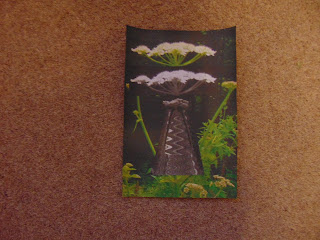I have made a few books in the past and used a variety of edges to decorate the borders. I quite like doing them and they do make a finish to a book. Here are some of ideas I use.
These borders are slightly different. A friend has these plastic rubbing strips and I took some impressions using Markel sticks and they are quite nice.
Lace is very useful for borders. The piece on the left has been dyed with transfer paints and is attached with two rows of running stitch which can be used on the reverse of the page but they are a bit wide apart for that. The one on the right has been more carefully attached with small stitches at each end of the opening. Again, not necessarily suitable on the reverse as the stitches are large on that side but they could have another thread wound through them. The piece on the right has a fancy thread couched down. Definitely not suitable on the reverse for showing so I would glue two pages together. The two rows of running stitch are threaded with another coloured thread to make an attractive pattern. This is useable on the reverse as the two rows match each other.
On the left I have painted a design which decorates one side of the page but leaves the reverse blank. The right hand side has fabric folded over the edge and stitched down. This creates an identical edge on the reverse. On the right I have done a single row of running stitch to show how it just finishes the page and the reverse is identical. On the right hand side I have torn the edge then added the piece I tore away, reversing it so that it fits in different places. This is glued to the reverse but is not unsightly so it could be used decoratively.
Unfortunately I had glued these pieces into my sketchbook before I realised I should have photographed the reverse sides. I did think not to glue in the areas where I might want to turn it over in the future and look at the other side but I can't hold them back and photograph them. This was a useful exercise to do, giving me a number of ideas I can look back on at a later date.













